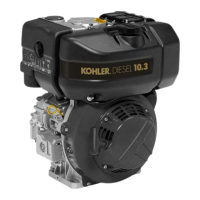2
- 8 -
SAFETY REGULATIONS
GENERAL REMARKS AND SAFETY INFORMATION
KD 225_315_350_400_440 Workshop Manual_cod. ED0053029330_1° ed_ rev.00
GENERAL NOTES
. Kohler engines are built to provide safe and longlasting
performances, but in order to obtain these results it is
essential that the maintenance requirements described in
the manual are observed along with the following safety
recommendations.
. The engine has been built to the specications of a
machinemanufacturer,anditishisresponsibilitytoensure
that all necessary action is taken to meet the essential
and legally prescribed health and safety requirements.
Any use of the machine other than that described cannot
be considered as complying with its intended purpose
as specied by Kohler, which therefore declines all
responsibilityforaccidentscausedbysuchoperations.
. The following instructions are intended for the user of the
machine in order to reduce or eliminate risks, especially
thoseconcerning the operationandstandard maintenance
oftheengine.
. The user should read these instructions carefully and get
toknowtheoperationsdescribed.Bynotdoingsohemay
placeatriskhis own healthandsafetyandthatofanyone
elseinthevicinityofthemachine.
. The engine may be used or mounted on a machine only
bypersonnelsuitablytrained in its operationandawareof
the dangers involved. This is particularly true for standard
and, above all, special maintenance work. For special
maintenance contact personnel trained specically by
Kohler.Thisworkshouldbecarriedoutinaccordancewith
existingliterature.
. Kohlerdeclinesallresponsibilityforaccidentsorforfailure
tocomplywiththerequirementsoflawifchangesaremade
totheengine’sfunctionalparametersortothefuelowrate
adjustments and speed of rotation, if seals are removed,
orifpartsnotdescribed in theoperatingandmaintenance
manual are removed and reassembled by unauthorized
personnel.
WARNING
. In addition to all other machine specications, ensure that
theengineisin a nearhorizontalpositionwhen starting. lf
starting manually, ensure that the necessary operations
canbeperformedwithout any riskofstrikingagainst walls
ordangerousobjects.Ropestarting(exceptforrecoilrope
starting)isnotpermittedeveninemergencies.
. Checkthatthemachineisstablesothatthereisnoriskofit
overturning.
. Get to know the engine speed adjustment and machine
stopoperations.
. Do not start the machine in closed or poorly ventilated
environments. The internal combustion process generates
carbon monoxide, an odourless and highly toxic gas, so
spending too long a time in an environment where the
engine discharges its exhaust products freely can lead to
lossofconsciousnessandevendeath.
. The engine may not be used in environments containing
ammable materials, explosive atmospheres or easily
combustible powders, unless adequate and specic
precautions have been taken and are clearly stated and
certiedforthemachine.
. Topreventtheriskofre,keepthemachineatadistanceof
atleastonemetrefrombuildingsorothermachines.
. Children and animals must be kept at a sufcient distance
from the machine to prevent any danger resulting from its
operation.
. Fuel is ammable, so the tank must be lled only when the
engine is turned off. Dry carefully any fuel that may have
spilled, remove the fuel container and any cloths soaked
in fuel or oil, check that any sound-absorbing panels made
of porous material are not soaked with fuel or oil, and make
surethatthegroundonwhichthemachineislocatedhasnot
absorbedfueloroil.
. Before starting, remove any tools that have been used for
carrying out maintenance work to the engine and/or the
machine and check that any guards removed have been
replaced. In cold climates it is possible to mix kerosene with
thedieselfueltomaketheengineeasiertostart.Theliquids
must be mixed in the tank by pouring in rst the kerosene
and then the diesel fuel. Consult Kohler technical ofce for
mixture proportions. Petrol may not be used because of the
riskofitformingammablevapours.
. During operation the surface of the engine reaches
temperatures that may be dangerous. Avoid in particular all
contactwiththeexhaustsystem.
. The liquid cooling circuit is under pressure. Do not carry out
any checks before the engine has cooled down, and even
then open the radiator cap or the expansion tank cautiously.
Wear protective clothing and glasses. lf there is an electric
fan,donotapproachtheenginewhileitisstillhotasthefan
maycomeonevenwhentheengineisnotrunning.Cleanthe
coolingsystemwiththeengineturnedoff.
. While cleaning the oil bath air lter, check that the oil is
disposed of in such a way as not to harm the environment.
Any ltering sponges in the oil bath air lter should not be
soakedwith oil.The cyclone pre-ltercup mustnot be lled
withoil.
. Sincetheoilmustbeemptiedoutwhiletheengineisstillhot
(approx. 80°C), particular care should be taken in order to
avoid burns. In any case make sure that oil does not come
into contact with your skin because of the health hazards
involved.
. Fuelvapoursarehighlytoxic,solluponlyintheopenairor
inwellventilatedenvironments.
. During operations which involve access to moving parts of
the engine and/or removal of the rotary guards, disconnect
andinsulatethepositivecableofthebatterysoastoprevent
accidentalshortcircuitsandactivationofthestartermotor.
. Checkthebelttensiononlywhentheengineisturnedoff.
IMPORTANT
. To start the engine follow the specic instructions provided
in the engine and/or machine operating manual. Do not
use auxiliary starting devices not originally installed on the
machine(e.g.Startpilotsystemswhichutiliseetheretc.)
. Before carrying out any work on the engine, turn it off and
allowittocooldown.Donotperformanyoperationwhilethe
engineisrunning.
. Check that the discharged oil, the oil lter and the oil
containedintheoillteraredisposedofinsuchawayasnot
toharmtheenvironment.
. Close the fuel tank ller cap carefully after each fílling
operation. Do not ll the tank right up to the top, but leave
sufcientspacetoallowforanyexpansionofthefuel.
. Donotsmokeorusenakedameswhilelling.

